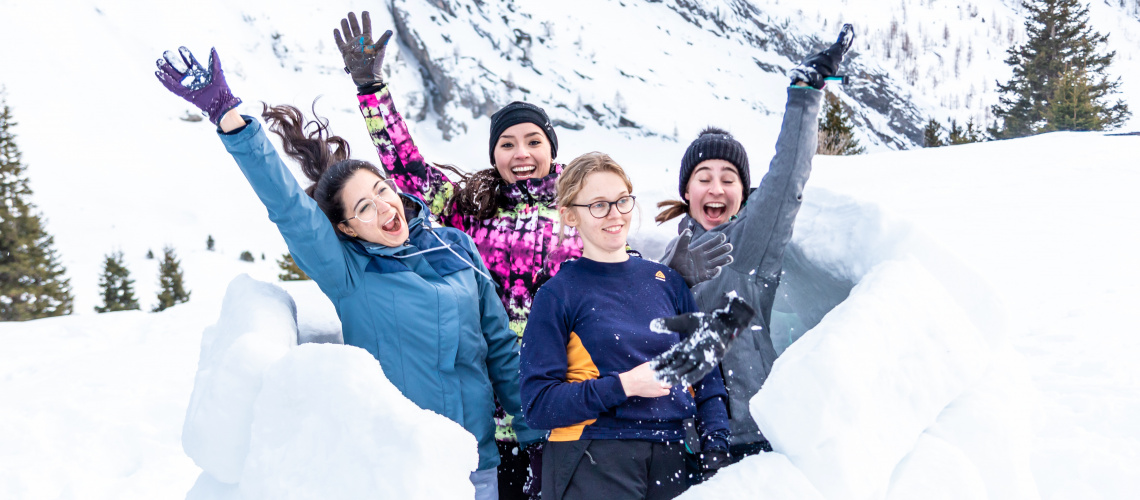Are you looking for a unique winter adventure? One that will take you off the beaten path and leave you with lasting memories? Look no further than iglooing. That’s right, building an igloo and spending the night in it is not only a fun activity but also a great way to connect with nature. In this ultimate guide to iglooing, we’ll cover everything from how to build an igloo to the best places to go on your next trip. So bundle up, grab some hot cocoa, and let’s dive into the world of iglooing!
Table of Contents
Are you looking for a unique winter adventure? One that will take you off the beaten path and leave you with lasting memories? Look no further than iglooing. That’s right, building an igloo and spending the night in it is not only a fun activity but also a great way to connect with nature. In this ultimate guide to iglooing, we’ll cover everything from how to build an igloo to the best places to go on your next trip. So bundle up, grab some hot cocoa, and let’s dive into the world of iglooing!
What is Iglooing?
Iglooing is a winter activity that involves building an igloo and spending the night in it. Igloos are dome-shaped snow structures that have been used for centuries by Inuit communities as shelter from harsh weather conditions.
Building an igloo may seem like a daunting task, but with some guidance and practice, it can be a fun and rewarding experience. The process involves packing snow into blocks using a shovel or saw, then arranging them in layers to create the walls of the igloo.
Once you’ve built your igloo, it’s time to settle in for the night. Sleeping inside an igloo can be surprisingly warm thanks to its insulating properties, which help trap body heat inside. It’s important to bring warm sleeping bags and pads for added comfort.
Iglooing is not only a unique winter adventure but also an opportunity to connect with nature and learn new skills. In addition to being fun, it can also teach valuable lessons about survival in extreme environments.
Whether you’re looking for a solo adventure or planning a group trip with friends or family, iglooing is definitely worth considering. So why not bundle up and give it a try on your next winter excursion?
How to Build an Igloo
Building an iglooing may seem like a daunting task, but it can be a fun and rewarding experience. Here are some tips to help you build your very own snow shelter.
First, find a suitable location with plenty of compacted snow. It’s important to make sure the snow is firm enough to hold its shape when cut into blocks.
Next, gather your tools: a shovel, saw or knife for cutting blocks, and a broom for smoothing surfaces.
Start by creating a circular base with several rows of block-shaped snow bricks. Work from the outside inwards until you reach the desired height.
Once you have completed your walls, carve out an entrance using the same technique as building walls but leaving an opening large enough to crawl through.
Create ventilation holes at the top to prevent carbon dioxide buildup inside by carving small openings throughout the dome roof.
Remember that building an igloo requires patience and practice; don’t get discouraged if it doesn’t turn out perfect on your first try!
The Best Places to Igloo
If you’re planning an iglooing adventure, choosing the right location is crucial. Here are some of the best places to igloo around the world.
Canada offers many scenic locations for iglooing, including Banff National Park and Lake Louise. In these areas, you can enjoy beautiful views of snow-capped mountains while sleeping in a cozy igloo.
Finland is another popular destination for igloo enthusiasts. Kakslauttanen Arctic Resort offers glass igloos with stunning views of the Northern Lights. You can also try traditional snow or ice hotels and sleep in a real-life winter wonderland.
For those seeking a more secluded experience, Alaska may be just what you need. With its vast wilderness and remote landscapes, it’s perfect for getting away from it all and enjoying nature at its finest.
Switzerland also has some great spots for building an igloo. The town of Gstaad even hosts an annual Igloo Festival where visitors can learn how to build their own icy abode.
No matter where you go, make sure to research local regulations before starting your adventure. And remember – safety first!
What to Pack for an Iglooing Trip
When packing for an iglooing trip, it’s important to keep in mind the harsh winter conditions that you will be facing. Here are some essential items to pack:
First and foremost, warm clothing is a must. Dress in layers and make sure to include thermal underwear, a thick sweater or fleece jacket, waterproof pants and jacket, wool socks, gloves or mittens and a hat.
Sleeping bags with adequate insulation are also crucial as temperatures inside the igloo can drop significantly at night. You may also want to bring along hand warmers or foot warmers if you tend to get especially cold.
Don’t forget about food! Pack high-energy foods that don’t require cooking such as trail mix, energy bars or jerky. Hot drinks like tea or hot chocolate can provide warmth and comfort during your stay.
Other essentials include headlamps with extra batteries (as sunlight is scarce during the winter months), snowshoes for exploring the area around your igloo site and a shovel for digging out your sleeping area.
Careful planning of what to pack is vital when embarking on an iglooing adventure – so take time to prepare ahead of time!
Tips and Tricks for a Successful Iglooing Adventure
When it comes to iglooing, preparation is key. Here are some tips and tricks for a successful adventure:
Firstly, make sure you have the right gear. Warm clothing that can withstand cold temperatures, waterproof boots, gloves and a hat are essential. Don’t forget sunglasses too – snow blindness is a real danger.
Secondly, choose your location wisely. Look for flat ground with plenty of snow coverage to build your igloo on. Avoid areas with potential avalanche risks or unstable terrain.
Thirdly, take the time to properly build your igloo using compacted snow blocks. Make sure it’s structurally sound before settling in for the night.
Fourthly, bring along a camping stove or other means of heating water so you can stay hydrated and warm up food if necessary.
Fifthly, be prepared for the darkness of winter nights by bringing along headlamps or other sources of light.
Remember that safety should always come first when iglooing. Be aware of weather conditions and potential hazards at all times during your trip!
Experience the Thrill of Iglooing: A Beginner’s Guide
Experience the Thrill of Iglooing: A Beginner’s Guide
If you’re looking for a winter adventure that’s out of the ordinary, iglooing might be right up your alley. But before you head out into the wilderness to build an igloo, there are a few things you should know.
First and foremost, it’s important to have some experience with cold-weather camping before attempting an igloo trip. This will give you an idea of what to expect in terms of temperature and conditions.
When building your first igloo, start small – building one large enough for just two people is a good idea until you get more comfortable with the process. Look for areas where there is plenty of snow available, but also make sure it’s not too loose or powdery.
Assemble all necessary tools beforehand including shovels (one big and one small), a saw or knife for cutting blocks, and a broom for sweeping up any excess snow inside the finished structure.
Once you’ve selected your site and gathered your materials, it’s time to begin constructing! The key is to cut uniform blocks from packed snow using either your saw or knife; these will be used as bricks when laying out each layer on top of another until reaching desired height.
Remember that proper ventilation is essential when sleeping in an igloo overnight – melting ice can cause condensation buildup which can lead to dampness inside the shelter. Air flow helps prevent this problem by allowing moisture to escape through air vents at its apex.
Finally always travel with someone else who knows how to create an igloo properly – while this type of camping can be fun alone if anything unexpected happens during construction or inclement weather hits unexpectedly having extra help around could mean life-saving assistance.
Conclusion
Iglooing is a unique and exciting winter adventure that anyone can enjoy. With the right preparation, knowledge, and equipment, you can explore the wilderness in comfort and style. From building your own igloo to camping with friends under the stars, there are endless possibilities when it comes to iglooing.
Remember to always check weather conditions before embarking on an iglooing trip and never go alone. Follow safety guidelines and respect nature for a fun-filled experience. Don’t forget to bring warm clothes, sleeping bags, food supplies, first aid kits among others for your trip.
I hope this ultimate guide has provided you with valuable insights into what iglooing is all about as well as tips and tricks that will make your next winter adventure memorable. Get out there today and embrace the thrill of Iglooing!





More Stories
The Ultimate Guide to Buy Hip Hop Beats for Your Next Track
Dressing Table: How to Choose the Perfect Makeup Vanity for Your Space
How to Plan Your Pittsburgh to Venice Trips: Tips and Advice